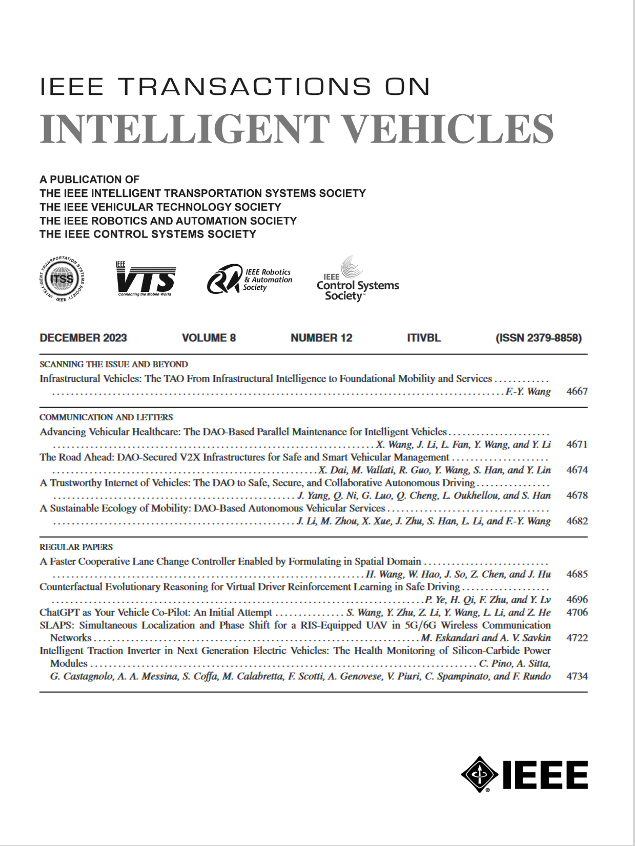Locational Intelligence Using GPS Trajectory Records of Courier Motorcycles
IF 14.3
1区 工程技术
Q1 COMPUTER SCIENCE, ARTIFICIAL INTELLIGENCE
引用次数: 0
Abstract
In recent years, the use of motorcycles has witnessed a remarkable surge in urban areas, paralleled by a growing demand for research and development in the motorcycle industry. Furthermore, the widespread adoption of GPS-enabled devices over the last few decades has opened up exciting possibilities, particularly in the realm of data analysis, where motorcycle GPS data has emerged as a valuable resource for various applications. This article presents a novel methodology for estimating the travel duration of powered two-wheelers (PTWs) in heterogeneous traffic using GPS data generated by motorcycles on urban road networks. The proposed methodology has the potential to offer valuable insights into the behavior of PTWs in heterogeneous traffic environments. By analyzing Big Data generated by GPS-based trajectory data, researchers can identify areas with high motorcycle density and pinpoint potential bottlenecks that impact travel times. Temporal data storing with bearing information in hexagonal shards called “bubbles” enables researchers to utilize Big Data more efficiently. Spatial transformation, Kalman filtering, and map-matching of the trajectory data significantly enhance the quality of the data. In this study, the 10-minute interval is performed as optimal for estimating travel time with 4.3% MAPE. Furthermore, combining historical bubble data with a 0.35 scale factor improves MAPE by 9.6%. Despite the limitations, not only is the transferability of this methodology noteworthy, but it is also opening the door to broader applications in diverse urban settings.利用快递摩托车的GPS轨迹记录进行定位情报
近年来,摩托车的使用在城市地区出现了显著的激增,与此同时,摩托车行业的研究和发展需求也在不断增长。此外,在过去的几十年里,GPS设备的广泛采用开辟了令人兴奋的可能性,特别是在数据分析领域,摩托车GPS数据已经成为各种应用的宝贵资源。本文提出了一种利用城市道路网络中摩托车产生的GPS数据来估计动力两轮车(PTWs)在异构交通中的行驶时间的新方法。所提出的方法有可能对异构流量环境中ptw的行为提供有价值的见解。通过分析基于gps的轨迹数据产生的大数据,研究人员可以识别出摩托车密度高的区域,并精确定位影响出行时间的潜在瓶颈。将承载信息的临时数据存储在被称为“气泡”的六边形碎片中,使研究人员能够更有效地利用大数据。对轨迹数据进行空间变换、卡尔曼滤波和映射匹配,显著提高了数据质量。在本研究中,以10分钟为最优间隔,以4.3%的MAPE估算出行时间。此外,将历史泡沫数据与0.35比例因子相结合,MAPE提高了9.6%。尽管存在局限性,但这种方法的可转移性不仅值得注意,而且还为在不同城市环境中更广泛的应用打开了大门。
本文章由计算机程序翻译,如有差异,请以英文原文为准。
求助全文
约1分钟内获得全文
求助全文
来源期刊

IEEE Transactions on Intelligent Vehicles
Mathematics-Control and Optimization
CiteScore
12.10
自引率
13.40%
发文量
177
期刊介绍:
The IEEE Transactions on Intelligent Vehicles (T-IV) is a premier platform for publishing peer-reviewed articles that present innovative research concepts, application results, significant theoretical findings, and application case studies in the field of intelligent vehicles. With a particular emphasis on automated vehicles within roadway environments, T-IV aims to raise awareness of pressing research and application challenges.
Our focus is on providing critical information to the intelligent vehicle community, serving as a dissemination vehicle for IEEE ITS Society members and others interested in learning about the state-of-the-art developments and progress in research and applications related to intelligent vehicles. Join us in advancing knowledge and innovation in this dynamic field.
 求助内容:
求助内容: 应助结果提醒方式:
应助结果提醒方式:


